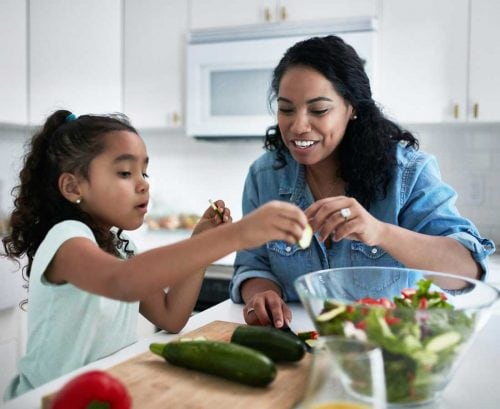
If you’re just starting out or you want to brush up on the basics, perfecting these five skills will set you up with a solid foundation as a healthy cook.
With these skills, you’ll always have the makings of a meal. What’s great is that with these as your base, you can have many, many different dishes.
1 Scramble an egg
Break 2 eggs per person into a bowl and whisk gently. Add 1 tablespoon milk per egg, salt, pepper and other seasonings, if you wish. Whisk well until a little bit frothy. Spray a pan with oil and heat over a medium-high heat. Add egg mixture and leave for 5 seconds, then start gently stirring with a spatula. You can gently tip the pan to help you get all the egg cooked. Think: ‘make a hole and fill it’. This should take only a minute or two. When all the egg is just cooked, it’s ready to serve, immediately.
Take it up a level: Serve your scrambled egg inside a tortilla with sauteed tomatoes, peppers, onion and Mexican spices, for huevos rancheros. Or try scrambled eggs with salmon.
2 Roast a chicken
Preheat your oven to 200°C (if you have fan bake, use it). Make a mixture of chopped herbs, such as parsley and sage, lemon zest, chopped garlic, a little salt and black pepper and olive oil. Place your prepared whole chicken in a close-fitting roasting dish. Slide your fingers between the flesh and the skin of the chicken breast and rub herb mixture in here. Rub any excess on the outside of the skin. Place half a lemon inside the chicken. Roast for approximately 20-25 minutes per 500g of chicken, or until the juices between the thigh and body are clear, not pink.
Tip: you can easily tell how heavy your chicken is from its size number: a size 12 is 1.2kg; a 13 is 1.3kg, etc. Try this roast chicken dinner.
3 Make a salad dressing
Elevate your salad with a delicious homemade vinaigrette. Combine one part acid, such as lemon juice, lime juice or vinegar, with two parts oil, such as olive, sesame, whatever you like. Add a dash of mustard and season to taste. Whisk or shake together to emulsify, and add to your salad bowl BEFORE you add the salad. Place leaves and other salad ingredients on top of the dressing, then gently toss to coat every leaf.
Vary your dressing: This base can be taken in a multitude of directions. Add different spices, herbs and flavourings; vary the oils for different flavours; try adding nut butters or tahini for creaminess or add chillies for heat.
4 Make a stir-fry
A stir-fry is a basic technique you can take in many directions. Use this basic formula: 1 portion of meat or other protein; 1 portion of carbohydrate food (rice, noodles, other starchy food); two parts colourful vegetables. Consider flavourings, too such as spices, herbs, nuts, seeds, sauces. Start by cutting all your ingredients into similar-sized pieces. Then heat a small amount of oil in a pan over medium-high.
Start with your protein; cook this on its own, in batches if you have lots of it. This will make sure the meat browns. If the pan is too crowded the meat won’t get hot enough, and will stew. Once the meat, chicken or tofu is browned and cooked to your liking, take it out of the pan and set aside. Then cook your vegetables: start with onion, garlic and spices, then add veges from hard to soft. For example, carrots are harder, so they’ll need longer to cook; spinach is soft and will only take a few moments, so add that last. When all veges are almost cooked, add your flavourings and sauces. Add the meat back in at the last minute, cook for a minute more and then remove from heat and serve with the carb (cooked noodles, rice, etc) of your choice.
Tip: remember a stir-fry doesn’t only have to be Asian in flavour; think about flavour profiles like Moroccan, Spanish or Mexican and let your imagination go.
5 Make pasta
If you’ve got pasta, you’ve got a meal. Start by bringing a big pot of water to the boil. Salt it well, then add your pasta of choice. No oil needed! Just give it a stir and cook to the packet instructions, until al dente (with a bit of bite). Drain, but make sure you keep a bit of pasta water aside to help make your sauce.
While pasta is cooking, make your choice of pasta sauce: it can be saucy, like a Bolognese, or chunky, including a mix of seasonal vegetables. Once your sauce and pasta are cooked, add pasta to sauce in pan, along with as much of the pasta water as you need to get a nice saucy texture and to get everything mixed well. Garnish your pasta with cheese, herbs, chili flakes and pepper.
Tip: Leftover pasta can be made into pasta salad; add cooked and raw veges and a vinaigrette, as per skill number 3, for an easy meal.
www.healthyfood.com










